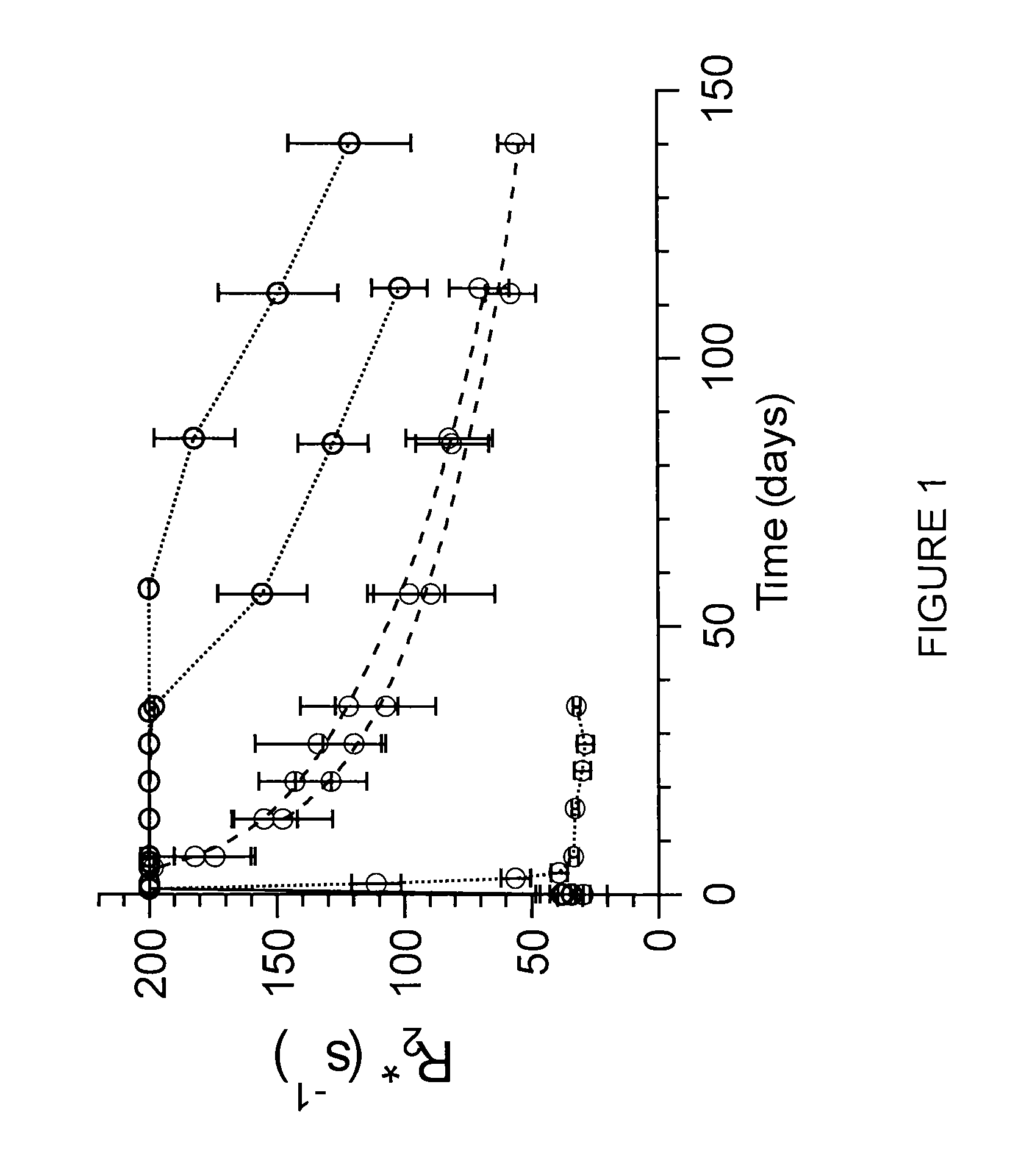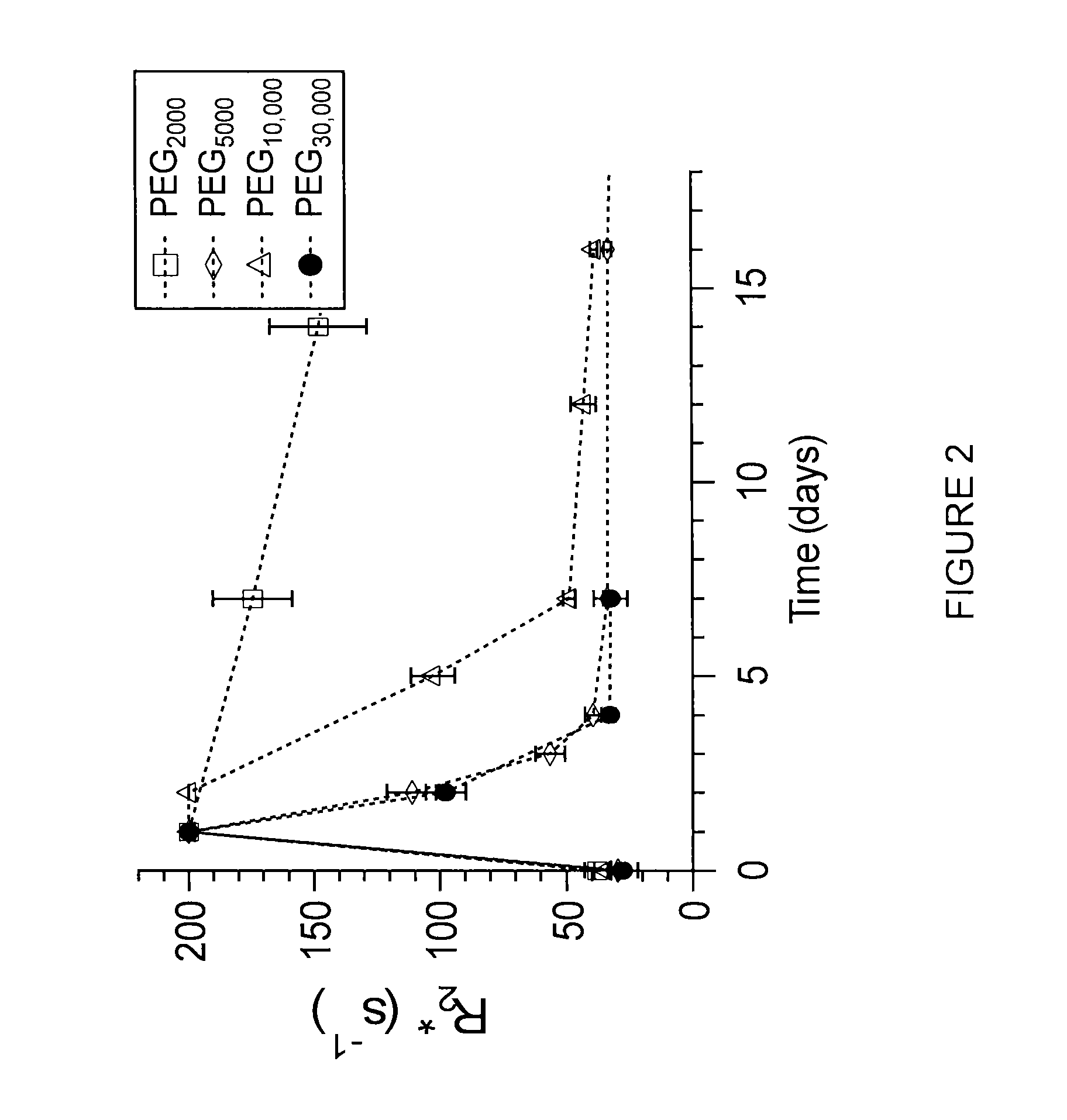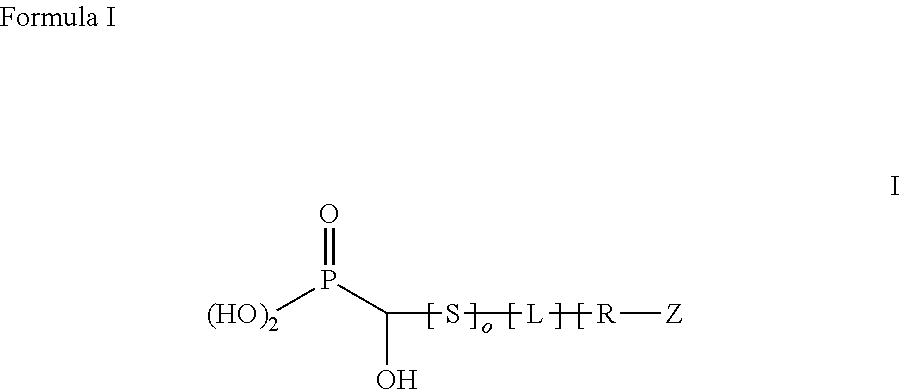Superparamagnetic nanoparticles with PEG substituted α-hydroxy phosphonate shells
a technology of -hydroxy phosphonate and superparamagnetic nanoparticles, which is applied in the field of nanoparticles, can solve the problems of little or no information regarding the in vivo behavior of these modified particles, and achieve the effects of increased stability in blood and serum, and rapid and complete liver processing
- Summary
- Abstract
- Description
- Claims
- Application Information
AI Technical Summary
Benefits of technology
Problems solved by technology
Method used
Image
Examples
example 1
Synthesis of a PEG-350 Conjugate
[0051]
Synthesis of PEG-350 mono(methyl ether) acetaldehyde
[0052]To a solution containing PEG-350 mono(methyl ether) (3.438 g, 9.82 mmol) dissolved in CH2Cl2 (98 mL) was added Dess-Martin Periodinane (5.00 g, 11.79 mmol) and the resulting solution was stirred at rt for 20 h. During the reaction a fine, white precipitate was formed and was removed at the end of the reaction via filtration through a celite pad. The solvent was removed from the filtrate in vacuo to leave a white solid suspended in a yellow oil. The solid was triturated with diethyl ether, and the solid was removed by filtration through a celite pad. Removal of the solvent from the filtrate in vacuo left the product PEG-350 mono(methyl ether) acetaldehyde (3.42 g, 100%) as a yellow oil. 1H NMR (CDCl3) δ 9.73 (t, J=4 Hz, 1H), 4.16 (d, J=4 Hz, 2H), 3.65 (m, 24H), 3.38 (s, 3H) ppm. IR (neat) 2873, 1732, 1455, 1350, 1109, 1040, 948, 851, 749 cm−1.
[0053]
Synthesis of diethyl α-hydroxy PEG-350 mo...
example 2
Synthesis of a PEG-1900 Conjugate
[0057]
Synthesis of mPEG2k-epoxide
[0058]A 2 L jacketed reaction vessel was purged with nitrogen and charged with epichlorohydrin (222.9 mL, 2.843 mol) followed by H2O (11.37 mL, 0.631 mol). After stirring at rt for 10 min, NaOH (113.7 g, 2.843 mol) was added and the resulting reaction slurry was heated to 72° C. PEG1900 mono(methyl ether) was added to the reaction and the resulting melt was stirred at 72° C. for 3 h. The reaction was then cooled to 35° C. and H2O (750 mL) was added. Once the reaction solution reached rt, the aqueous reaction solution was extracted with CH2Cl2 (2×750 mL). The solvent was then removed from the combined organic extracts in vacuo to give a tan / brown solid. The solid was dissolved in CH2Cl2 (750 mL) and the resulting cloudy solution was passed through a celite pad. The solvent was removed from the resulting clear orange filtrate in vacuo to leave a waxy, tan solid. The recovered solid was recrystallized 2× from 2:1 THF / hex...
example 3
Synthesis of αPEG-5000 Conjugate
[0067]
Synthesis of mPEG5k-epoxide
[0068]Water (4.32 mL) was suspended in epichlorohydrin (84.68 mL, 1.080 mol) and NaOH (43.20 g, 1.080 mmol) was added followed by triethylammonium hydrochloride (1.18 g, 0.009 mol). The solution was stirred and heated to 70° C. during which time PEG5000 mono(methyl ether) (500 g, 0.100 mol) was added in portions as the temperature rose. The resulting suspension was stirred at temp for 4 h and then cooled to rt. Water (500 mL) was added and the product was extracted with CH2Cl2 (2×1000 mL). The CH2Cl2 was removed in vacuo (not to dryness—but only to a thick oil) and the resulting oil was recrystallized from THF (400 mL) / hexanes (200 mL) (add THF, heat and then add hexanes, swirl until cloudiness clears ˜30 s) to give 499.93 g (99% of theoretical mass) of the desired product as an off white solid: 1H NMR (CDCl3) δ 3.81 (m, 2H), 3.64 (m, 422H), 3.46 (m, 2H), 3.38 (s, 3H), 3.17 (m, 1H), 2.79 (m, 1H), 2.61 (m, 1H). 13C NMR ...
PUM
| Property | Measurement | Unit |
|---|---|---|
| molecular weight | aaaaa | aaaaa |
| average hydrodynamic diameter | aaaaa | aaaaa |
| hydrodynamic diameter | aaaaa | aaaaa |
Abstract
Description
Claims
Application Information
 Login to View More
Login to View More - R&D
- Intellectual Property
- Life Sciences
- Materials
- Tech Scout
- Unparalleled Data Quality
- Higher Quality Content
- 60% Fewer Hallucinations
Browse by: Latest US Patents, China's latest patents, Technical Efficacy Thesaurus, Application Domain, Technology Topic, Popular Technical Reports.
© 2025 PatSnap. All rights reserved.Legal|Privacy policy|Modern Slavery Act Transparency Statement|Sitemap|About US| Contact US: help@patsnap.com



